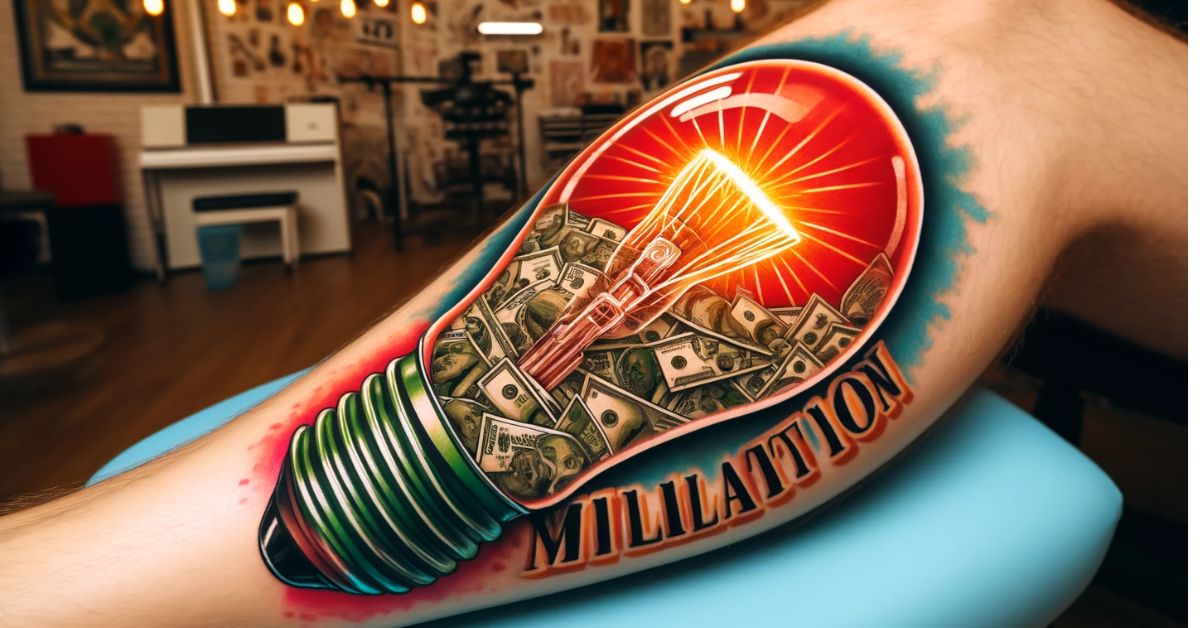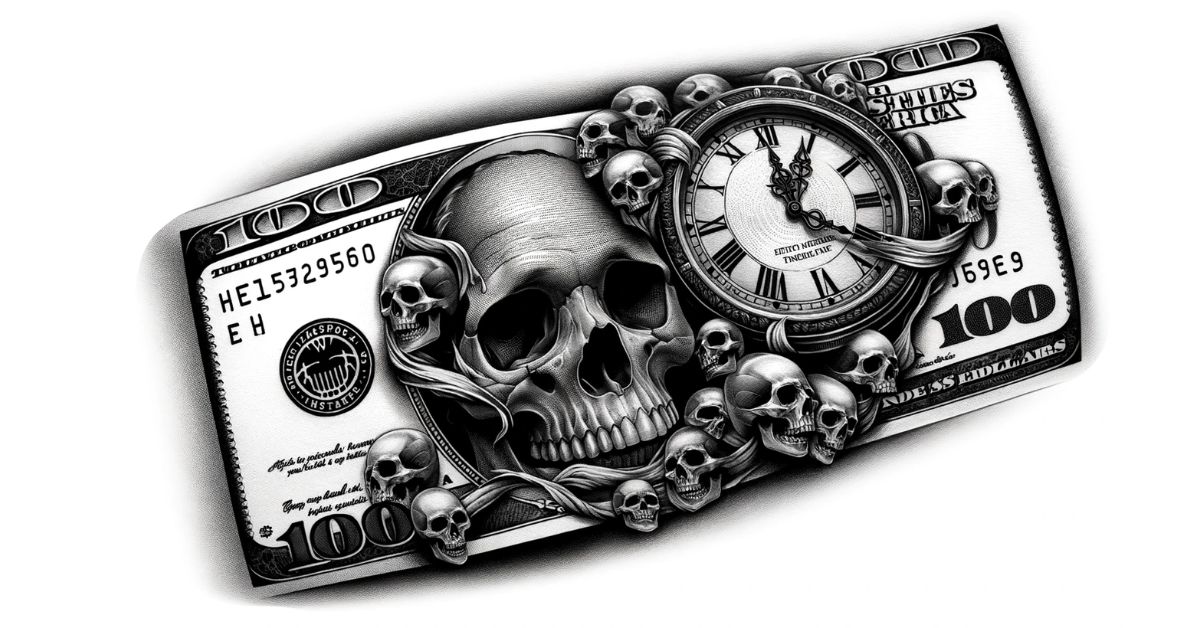Explore the fascinating world of 100-dollar bill tattoos, a blend of artistry and symbolism. Whether it’s a badge of success or a critique of materialism, these tattoos carry deep meanings. Discover a great selection of 100 dollar bill tattoo ideas below, each telling a unique story.
100-dollar bill tattoos encapsulate a fascinating blend of affluence and artistry, serving as much more than just skin deep adornments. They are symbols of financial aspiration, personal achievements, and sometimes, a critique of the very fabric of materialism. This distinctive ink reflects both personal narratives and cultural commentary, making each tattoo a unique piece of art. Whether it's through intricate designs that echo the complexity of wealth or through stark, powerful imagery that questions its value, these tattoos invite onlookers into a deeper dialogue about what prosperity truly means in today's society.
The 100-dollar bill tattoo is not just a display of wealth but a rich narrative embroidered on the skin that often carries deeper meanings of success, ambition, and sometimes, defiance against conventional norms. These tattoos often reflect a person’s relationship with money, symbolizing either a motivation for prosperity or a critical commentary on materialism. They are particularly popular among individuals who view the economic symbol as a form of art or a statement piece.
One of the most intriguing designs is the Money Heist-inspired 100-dollar bill tattoo, where the face of Benjamin Franklin is replaced with the iconic Salvador Dali mask and a red tracksuit, reflecting themes of rebellion and resistance from the popular television series.
Another creative rendition is the "Million Dollar Idea" tattoo, which features a light bulb filled with 100-dollar bills. This design plays on the notion that ideas are as valuable as tangible currency, emphasizing creativity and intellectual wealth over physical money.

Sleeve tattoos that incorporate 100-dollar bills often include elements like dice and playing cards, hinting at the gambles and risks taken in life and business. These designs can cover the entire arm in a grayscale theme, making a bold statement about one's life choices and challenges.
The choice of placement for a 100-dollar bill tattoo can vary significantly depending on the personal meaning assigned to it by the wearer. Common spots include:
From photorealistic approaches that capture every detail of the bill to more abstract renditions that incorporate symbolic elements, the artistic styles of 100-dollar bill tattoos vary widely. Some artists use black and grey ink to highlight the sharpness of the bills, while others may introduce vibrant colors to emphasize certain aspects, like the green hue of the money or thematic additions like flames or additional graphical elements.
The cultural perceptions surrounding 100-dollar bill tattoos are as varied as the designs themselves. In some circles, these tattoos are seen as badges of honor, representing financial success or aspirations. In others, they may be viewed critically, seen as ostentatious displays of wealth or symbols of materialism. This dichotomy reflects broader societal attitudes towards money and wealth, where the line between admiration and critique often blurs.
In Western cultures, particularly in the United States, the 100-dollar bill is often associated with high economic status and success. Tattoos featuring this motif can either celebrate these values or critique the very idea of wealth accumulation. Meanwhile, in other parts of the world, similar currency-themed tattoos might carry different connotations, often shaped by local economic conditions and cultural histories.
100-dollar bill tattoos also hold a significant place in pop culture, influenced heavily by celebrity endorsements and appearances in media. These tattoos are popular among musicians, athletes, and social media influencers, which further propels their appeal among younger demographics. This visibility can sometimes glamorize the pursuit of wealth, influencing young people's attitudes towards money and success.
As tattoo art continues to evolve, so do the trends surrounding currency-inspired designs. Artists are pushing the boundaries of traditional imagery to include more creative and abstract interpretations of the 100-dollar bill.
Recent trends include blending the 100-dollar bill with other symbolic elements like clocks, skulls, or geographical landmarks, infusing the designs with personal meaning or social commentary. For example, a 100-dollar bill merged with a clock may symbolize the phrase "time is money," emphasizing the value of time as a commodity.

While traditional 100-dollar bill tattoos often utilize a monochrome palette to mimic the look of actual currency, modern versions are seeing an infusion of color. Artists use greens, blues, and even reds to highlight specific features or add a new dimension to the artwork. Techniques like watercolor, hyper-realism, and neo-traditional styles are also becoming more prevalent, showcasing the versatility of this theme in tattoo art.
Exploring the personal significance of 100-dollar bill tattoos reveals a tapestry of stories that range from triumphs and aspirations to critiques of societal norms. Each tattoo holds a unique narrative, shaped by the individual’s experiences and beliefs.
Many choose the 100-dollar bill tattoo as a symbol of their financial goals or achievements. For example, entrepreneurs might get this tattoo after reaching a significant milestone in their business, seeing it as a perpetual motivator to pursue further success. Others view it as a reminder of their journey from financial instability to security, a permanent marker of their hard work and perseverance.
Conversely, some individuals use the 100-dollar bill tattoo to critique the very concept of material wealth. These tattoos might incorporate ironic elements or juxtapositions that highlight the transient or corrupting nature of money. For instance, merging a 100-dollar bill with images of decay or traditional symbols of mortality can serve as a poignant commentary on the impermanence of wealth.
In some cases, currency tattoos can also represent a connection to one’s cultural or national identity, especially among those from countries with significant diasporas. For these individuals, a 100-dollar bill tattoo might symbolize the American dream, representing hope, ambition, and the pursuit of opportunity.
Tattoo artists who specialize in currency-themed tattoos often share insights into the trends and preferences that shape their work. They note an increasing demand for designs that not only replicate currency but also reinterpret it in ways that reflect the client’s personality or artistic vision.
Clients frequently request custom elements to be incorporated into their 100-dollar bill tattoos, such as dates, names, or meaningful quotes. This personalization makes each piece unique and tailored to the individual’s life story or personal philosophy.
Artists also discuss the technical challenges associated with replicating the intricate details of currency. Mastery in fine line work and shading is crucial to capture the likeness of the engravings found on bills. Some artists blend traditional techniques with modern digital design tools to pre-visualize and perfect their designs before inking.
The popularity of 100-dollar bill tattoos also influences broader tattoo trends, encouraging more people to choose complex, meaningful designs that go beyond aesthetic appeal. These tattoos often start conversations about the values and stories that people choose to embody through their body art.
The significance of 100-dollar bill tattoos extends beyond their visual appeal, weaving into the fabric of personal identity and societal values. These tattoos often reflect a complex interplay between personal aspirations and cultural critiques, serving as a canvas for individuals to express their philosophies, struggles, and achievements.
For many, a 100-dollar bill tattoo is not merely a representation of wealth but a broader statement about personal identity and the values they hold dear. It can symbolize resilience in the face of economic adversity or a critique of societal materialism. This duality underscores the personal and societal narratives that these tattoos can embody, making them a powerful tool for self-expression.
Tattooing, at its core, is transformative—not just in the physical sense but also in how it allows individuals to reclaim and reshape their identities. The process of choosing and getting a tattoo can be a cathartic experience, especially for those who see their tattoos as milestones or as parts of healing from past traumas. The 100-dollar bill, a symbol laden with connotations of power and success, can be particularly impactful in this transformative context.
Tattoo artists play a crucial role in translating the complex symbolism of a 100-dollar bill into a piece of art that resonates on a personal level. Their skill in integrating personal stories with cultural symbols can alter or reinforce perceptions of these tattoos within the community. By discussing their clients' intentions and stories, artists help to foster a deeper understanding of the motivations behind currency-themed tattoos.
The prevalence of 100-dollar bill tattoos also prompts broader discussions about the role of money in society. These tattoos often spark conversations about wealth distribution, economic justice, and the personal impact of financial systems. By wearing these symbols on their skin, individuals can engage in and promote a dialogue about these critical issues, using their bodies as platforms for social commentary.
As tattoo culture continues to evolve, the 100-dollar bill tattoo remains a poignant reminder of the complex interplay between art, identity, and economics. It challenges observers to consider not only the aesthetic qualities of the design but also the broader implications of the symbols we choose to carry with us. Through this lens, the tattoo transcends its role as mere decoration, becoming a dynamic form of personal and political expression.
Copyright © 2025 Tat-ideas.com | Cookies and privacy policy | About